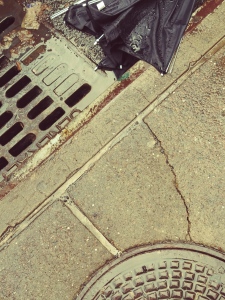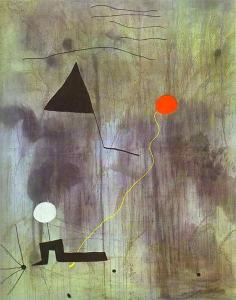Since major losses are unavoidable, what can we control? Perhaps our reaction to the small stuff, the daily indignities and frustrations: the inevitable bruising in a crowded, high-speed, super-tech world preoccupied with itself.
Enlarge the meaning of those events and you will sink to the point of drowning.
You needn’t.
Maybe Joan Miró can help.
I was on the wet way to the Museum of Modern Art. Spirit-sucking morning weather was not predicted. No mention of violently chilly rain, driven in horizontal body blows by the air. The leering wind lifted skirts, groping for female skin. People halted at the lip of the 57th St. subway exit to avoid the deluge, lest umbrellas turn inside out.
An annoyance only, I thought or tried to think. I’ll soon be at the Miró exhibition.
Poor planning. Spain waited for me.
An entire country, to my surprise, was on Spring Break. Every Spaniard (so it seemed) left home to see the work of their Catalan/Spanish countryman, Joan (pronounced Juan) Miró. The 54th street lobby, the size of a high vaulted, grand church nave, impersonated a forest of bodies: little bodies held by big bodies, vigorous and infirm torsos, people in your way and you in theirs. The ticket-issuers were past the horizon.
I considered whether the art would be worth the travail, hidden behind the mob of which I was a part. Instead I pushed on, avoided the block-long coat-check line, and chanced no one would steal my umbrella from the unguarded stand on the wall.
The slow-mo mass inched when it could, grew when it couldn’t. My elevator made its tardy human deposit on the third floor, revealing a new throng already there. One stepped around traffic in front and beyond the drawings and paintings. Chatter above and a drone below. Periscopes were not for sale.
But then Miró appeared!
Not the artist himself, dead since 1983. I’d not known much about him. Unfamiliar art must be encountered with an open mind. To achieve an aesthetic connection one must engage the maker. A passive viewer, waiting for a painter to do something to him, is unprepared.
Miró’s work is hallucinatory, not of this world, outside the real. Hitch a ride with him and he focuses you elsewhere, on escape, one of his personal preoccupations.
The lump of bodies no longer mattered much. The Catalan and I engaged in unheard dialogue. “Look here,” he whispered. “I’ll part the sea of souls between us.”
Even Alexander — he of the “terrible, horrible, no good, very bad day” — might have enjoyed it.
Here is advice, offered in the hope you will manage with grace most of the frustrating, sub-catastrophic times ahead.
- Fill your lungs to unwind the coiled spring inside you.
- Do not require perfection of life in any circumstance, except perhaps surgery. People cough when the music is still, highways suffer congestion when you are late, and any queue you choose will be the wrong one. Reframe your situation. The Buddah would suggest these obstacles offer you an opportunity to learn patience, for which gratitude (not resentment) is an appropriate response. Your choice.
- Remember, you are not alone. All in the legion of Miró’s admirers were at the mercy of themselves and each other. Though well-behaved, they doubtless wanted a solo turn in front of the art as much as I. Many had crossed the ocean for it.
- Save your indignation, disappointment, and sadness for bigger things. The life-wrenching, knee-buckling, terrifying battalions led by an indifferent Fate will visit soon enough. Small disturbances would escape your biographer’s attention. Make your life larger than such incidents.
- Be open to possibility: the delightful surprises, the beauty in the everyday, the small kindnesses others bestow upon you or you on them. In the course of my time at the museum I chatted with a couple of uniformed attendants who protect the collection, deal with emergencies, and give directions. They are people, too — challenged to keep a silent presence while performing their invisible work. A blind John Milton saw enough to know, “They also serve who only stand and wait.”
Do not think I am never maddened or impatient, unhappy with the conditions in which I find myself. But I try to effect change where I can, welcome the possible, and accept what is not.
Life offers many opportunities to make ourselves better and take in the loveliness still present in the world. Do not miss your Miró-moments, whenever they come.
—–
The Miró paintings begin with Persons Haunted by a Bird (1938), The Green Moon (1972), The Birth of the World (1925), and Painting (1950). The second image was one I took on the day in question, on Broadway near 57th St., New York.





